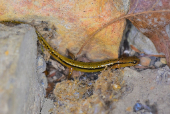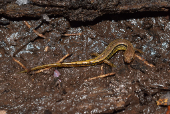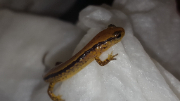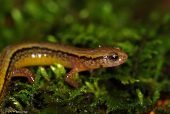Southern Two-Lined Salamander (Eurycea cirrigera)
Description: The southern two-lined salamander is a small thin salamander, distinguished by the two lines running down the lateral portion of its body. The salamander is deep-light brown and fairly small, growing up to 6.5 to 12 cm in length. The species has 14 costal grooves between its limbs. The key difference between the Southern two lined salamander from the Northern two lined salamander is that the black lines run all the way down to the tail. When the salamander reaches sexual maturity males begin to show Cirri and enlarged jaw muscles.
Habitat: These salamanders are semi-aquatic and may be found in and around streams, seeps, pools, and ditches. These salamanders are most commonly found in water during the breeding season, which begins in late spring. At other times of the year, these salamanders move into the woods surrounding their aquatic habitats.
Range: Southern Two-Lined Salamanders are found throughout the Southeast, except for peninsular Florida. They are found throughout Georgia and South Carolina.
Diet: Southern two-lined salamanders consume primarily small invertebrates but will occasionally consume smaller salamanders.
Reproduction: The breeding season begins in late winter or early spring. Females typically guard their eggs until they hatch. At this time, females deposit their eggs under rocks, logs, or leaves in water. Hatchling salamanders emerge from their eggs with external gills and spend around 2 years as fully aquatic larvae before transforming into adults.
Status: Listed as Least Concern in view of its wide distribution, presumed large population, and because it is unlikely to be declining fast enough to qualify for listing in a more threatened category.
»» Kingdom: Animalia - Animals
»» Phylum: Chordata - Chordates
»» Subphylum: Vertebrata - Vertebrates
»» Class: Amphibia - (Amphibians)
»» Order: Caudata - Salamanders
»» Family: Plethodontidae - Lungless Salamanders
»» Genus: Eurycea
»» Species: Eurycea cirrigera - Southern Two-Lined Salamander
This article uses material from the Wikipedia article "Southern Two-Lined Salamander", which is released under the Creative Commons Attribution-Share-Alike License 3.0. Content may have been omitted from the original, but no content has been changed or extended.
|













